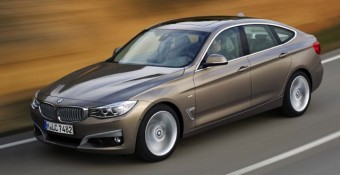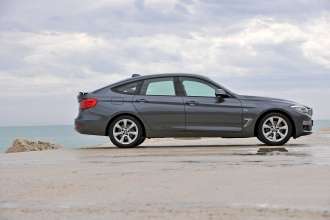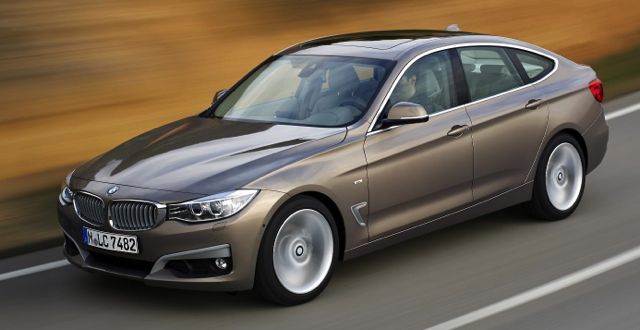 The 3 Series is BMW’s globally best selling model range and in the UK is the best selling premium brand car.
The 3 Series is BMW’s globally best selling model range and in the UK is the best selling premium brand car.
Global sales are up by 20% again this year. Last year in the UK’s top ten sales chart of best selling cars the 3 Series range finished in seventh position overall with 44,521 registrations, impressive for an expensive premium brand of executive models.
The 3 Series accounted for 34% of all BMW 127,530 new car sales in the UK last year. The new four door Saloon accounted for 19% (29,543 units), the new Touring estate 6% (6,904 units) and the older Coupe/Convertible models 9% between them (4,827 Coupes and 3,247 Convertibles).
But from May there is another version to be added to the line-up, the five door coupe/hatchback styled Gran Coupe. The GT is the third of five body styles for the latest generation 3 Series range. New Coupe and Convertible models will arrive in due course.
The longer wheelbase GT or Gran Turismo is roomier for rear seat passengers compared to any 3 Series model ever and offers more load space than even the latest 3 Series Touring. The new model is expected to achieve 4,000 UK sales in a full year with prices ranging from £28,830 up to £38,470. On average the new GT carries a £1,300 price premium over the comparable Touring model.
Initially the first ever 3 Series GT will be available with three petrol engines, (320i, 328i and 335i) and two turbodiesel units, (318d and the best selling 320d) and up to four trim levels. These engines will account for 80% of GT sales in the UK. In July additions to the range will be the 325d, the 320i xDrive 4×4 and the option of M Sport trim and more xDrive versions will be added next year.
At launch the GT is available with the main SE specification but in addition Sport and Modern variants cost £1,000 more and a Luxury specification adds £2,000 over the SE level. Of course there is a huge array of options that will push the price up further.
Natasha Newman, BMW UK’s product operations manager said at the UK media launch that 60% of GT sales are expected to go to business and fleet drivers and 70% of total sales will be diesel powered models.
The majority of GT sales will go to conquest customers although some current 3 Series owners will find the increased rear seat legroom appealing and some 5 Series retail owners, probably ‘empty nester’s and company car drivers wishing to reduce their Benefit-in-Kind tax, could down-size to the GT.
The key point to the 3 Series Gran Turismo is its size and styling. It has a sportier, taller and longer five door body with a coupe side profile. It has a number of unique styling points over other 3 Series models such as headlight design, under front bumper tweaks in the form of air vents, air flow outlet vents in the lower side of the front wings, a rising waistline, coupe roofline, sculptured lower side door panels, a steeply raked tailgate at the rear with an automatic raising and lowering rear spoiler but unfortunately no tailgate wiper/wash unit.
A rear wash/wipe is not in keeping with BMW’s coupe DNA I’m told.
At 4,824mm in length the GT is 200mm longer than the 3 Series Touring, it is 1,489mm tall, 81mm more than the Touring so despite its coupe profile headroom is plentiful even in the rear three seats. For better visibility and comfort the seats are 59mm higher than in the Touring.
 Rear seat passengers benefit most because the wheelbase over the Touring models is increased by 110mm so rear seat legroom, the Achilles heal of the 3 Series, is increased by 75mm so its impressively better and now almost the same as a 5 Series Saloon. The transmission tunnel does however still restrict the foot space for the centre rear seat passenger.
Rear seat passengers benefit most because the wheelbase over the Touring models is increased by 110mm so rear seat legroom, the Achilles heal of the 3 Series, is increased by 75mm so its impressively better and now almost the same as a 5 Series Saloon. The transmission tunnel does however still restrict the foot space for the centre rear seat passenger.
The three rear seats, with folding head restraints, can be split 40/20/40 and reclined in 15 stages. They can also be easily folded down to increase the load carrying space. The load capacity offered by the GT is more than that available in the 3 Series Touring as well.
With all the seats in use there is 520-litres of luggage space, fold down the seats and this goes up to an impressive 1,600-litres, 25 to 100-litres more than the Touring. The GT’s tailgate is electrically operated and reveals a wide aperture to the boot and load area.
Standard equipment includes 18-inch alloy wheels, two-zone air conditioning, Bluetooth, USB, 6.5-inch control display screen, the usual iDrive Controller, drive performance control with ECO PRO with Comfort, Sport and Sport+ modes, parcel shelf, rear parking distance sensors plus all the usual features such as electric windows/mirrors, cruise control, stability/traction/brake cornering controls and run flat tyres.
There is no spare wheel, even as an option and the space under the boot floor is taken up by extra fixed storage compartments.
The added items of equipment on offer are numerous and include multimedia navigation, head-up display, park assist, active cruise control, Stop&Go, leather upholstery, variable sports steering and adaptive M Sport suspension. To showcase the many and varied extra cost options available my test car, the 318d Sport Gran Turismo which has a price of £30,910, fully loaded eventually had an on-the-road price of £41,945. Not many people will go that extreme with adding options and Benefit-in-Kind tax costs to their GT but they could if they wished.
But back to earth, Tuscany to be precise and the winding hilly roads for my first drive in the new BMW 3 Series Gran Turismo. Unfortunately the main selling 320d SE 184hp four cylinder turbodiesel models returning an official 57.6mpg with CO2 emissions of 129g/km were yet to arrive with BMW UK so the next best selling version, the 318d, 143hp turbodiesel was my choice for a GT experience. This model in SE spec level costs £29,910 but the Sport pack version as tested added £1,000 to that price.
The power-house is a 2.0-litre, four cylinder variable twin scroll turbodiesel with common-rail injection and all the usual BMW EfficientDynamics fuel saving and power harvesting technology. Because it delivers a healthy 320Nm (236lb ft) of torque from under 2,000rpm it’s a responsive unit despite its fuel saving sixth gear ratio in the manual gearbox.
 The main question about the Gran Turismo is does its extra length and more interior space detract from the impressive handling and agility qualities the 3 Series Saloon and Touring models are renowned for?
The main question about the Gran Turismo is does its extra length and more interior space detract from the impressive handling and agility qualities the 3 Series Saloon and Touring models are renowned for?
They are recognised as the best performing compact executive cars available today and the GT addition doesn’t really change that to any great extent.
The handling is not quite as sharp and agile due to the extra weight of the elongated body-shell and the longer wheelbase doesn’t make it quite as precise during cornering or travelling over undulating roads but ride comfort at high cruising speeds is impressive especially if the suspension mode is left in Comfort.
VERDICT
It is not a sports saloon or estate, it’s a Gran Turismo meant for touring so long-legged cruising on open roads suits it best.
There seemed to be more road noise intrusion from the tyres and rear suspension copying with potholes due to the fact that it is a hatchback so the load area is not insulated from the cabin.
Whatever the roads being travelled rear seat passengers will enjoy the significantly improved leg and headroom and the extra load space is always useful.
MILESTONES
BMW 3 Series 318d Sport Gran Turismo £30,910.
Engine/transmission: 2.0-litre, four-cylinder common-rail turbodiesel 143hp, 320Nm £236lb ft of torque, 6-speed manual gearbox, rear wheel drive
Performance: 130mph (restricted), 0-62mph 9.7 seconds, 62.8mpg (41.8mpg on test), CO2 119g/km, VED road tax £0 First Year rate then £30 second year onwards, BIK company car tax 17%
Insurance group: 24.
Dimensions/capacities: L 4,824mm, W 1,828mm, H 1,489mm, 5-doors/5-seats, boot/load space 520 to 1,600-litres
For: More rear legroom for rear seat passengers, more load space than a 3 Series Touring estate, raised driving position, well equipped
Against: Not as agile and precise in the handling departments as the 3 Series Saloon/Touring.

